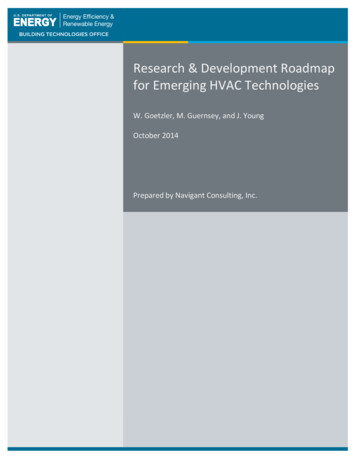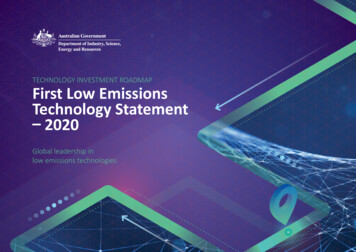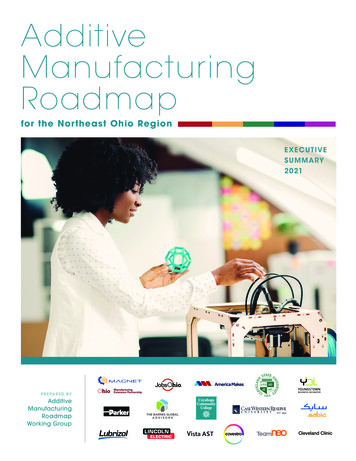
Transcription
Research & Development Roadmapfor Emerging HVAC TechnologiesW. Goetzler, M. Guernsey, and J. YoungOctober 2014Prepared by Navigant Consulting, Inc.
(This page intentionally left blank)
NOTICEThis report was prepared as an account of work sponsored by an agency of theUnited States Government. Neither the United States Government, nor anyagency thereof, nor any of their employees, nor any of their contractors,subcontractors, or their employees, makes any warranty, express or implied, orassumes any legal liability or responsibility for the accuracy, completeness, orusefulness of any information, apparatus, product, or process disclosed, orrepresents that its use would not infringe privately owned rights. Referenceherein to any specific commercial product, process, or service by trade name,trademark, manufacturer, or otherwise, does not necessarily constitute or imply itsendorsement, recommendation, or favoring by the United States Government orany agency, contractor or subcontractor thereof. The views and opinions ofauthors expressed herein do not necessarily state or reflect those of the UnitedStates Government or any agency thereof.Available electronically at http://www.osti.gov/home/
RESEARCH AND DEVELOPMENT ROADMAP FOR EMERGING HVAC TECHNOLOGIESPrefaceThe Department of Energy’s (DOE) Building Technology Office (BTO), a part of the Office ofEnergy Efficiency and Renewable Energy (EERE) engaged Navigant Consulting to develop thisresearch and development (R&D) roadmap for heating, ventilation, and air conditioning (HVAC)technologies. The initiatives identified in this report are Navigant’s recommendations to BTOfor pursuing in an effort to achieve DOE’s energy efficiency goals. Inclusion in this roadmapdoes not guarantee funding; HVAC initiatives must be evaluated in the context of all potentialactivities that BTO could undertake to achieve their goals.BTO also manages the residential appliance and commercial equipment standards program;however these activities are separate. To maintain the separation between the emergingtechnologies activities and the appliances standards activities, and to prevent undesirableinteraction between the two, this roadmap does not cover any details of the following topics(general discussion of challenges, barriers, or needs in these areas may be covered asappropriate):» Test procedures» Energy efficiency descriptors» Efficiency standards levels.Prepared for:U.S. Department of EnergyOffice of Energy Efficiency and Renewable EnergyBuilding Technologies Officewww.eere.energy.gov/buildingsPrepared by:Navigant Consulting, Inc.77 South Bedford Street, Suite 400Burlington, MA 01803William GoetzlerMatt GuernseyJim Youngii Preface
RESEARCH AND DEVELOPMENT ROADMAP FOR EMERGING HVAC TECHNOLOGIESAcknowledgementsWe would like to thank the individuals who provided valuable input to this roadmap, including:NameOrganizationOmar AbdelazizVan BaxterAnil BhargavaAntonio BouzaCraig BradshawRobert ComparinDan DempseyMichael DeruTitu DoctorIan DoebberPiotr DomanskiNicholas FilaDouglas FriedmanBrian FronkBrendan GardesAshok GidwaniChris GraySteve GreenbergChad GriffithJill HootmanShaobo JiaBrian JohnsonSrinivas KatipamulaGeorgi KazachkiThomas LeckJason LeRoyDick LordChris MullerJoe OroszHung PhamPat PhelanReinhard RadermacherAri ReevesTom SayreKen SchoeneckMick SchwedlerHarris SheinmanMark SpectorKristen TaddonioTroy TrantU.S. Department of Energy, Building Technologies OfficeOak Ridge National LabI & M Industrials, Inc.U.S. Department of Energy, Building Technologies OfficeTorad EngineeringEmerson Climate TechnologiesCarrierNational Renewable Energy LaboratoryCENC Inc.National Renewable Energy LaboratoryNational Institute of Standards and TechnologyHeery International, Inc.LabWize, Inc.Georgia Institute of TechnologyDLB AssociatesBooz Allen Hamilton / ARPA-eSouthern CompanyLawrence Berkeley National LaboratoryGriffith EngineeringTraneHeatcraft RefrigerationDais Analytic CorporationPacific Northwest National LaboratoryDayton Phoenix Group, Inc.DuPontTraneCarrierPurafil, Inc.Torad EngineeringEmerson Climate TechnologiesU.S. Department of Energy, Building Technologies OfficeUniversity of MarylandCLASPSizemore GroupIngersoll RandTraneHeery International, Inc.Office of Naval ResearchU.S. Department of Energy, Building Technologies OfficeRheem Manufacturing CompanyAcknowledgements iii
RESEARCH AND DEVELOPMENT ROADMAP FOR EMERGING HVAC TECHNOLOGIESNameOrganizationDutch UseltonParmesh VermaEd VineyardEric WalthallXudong WangDavid WassermanThomas WatsonRobert WilkinsJing ZhengTony ZieglerLennoxUTRCOak Ridge National LabDanfossAHRISouthfaceDaikin AppliedDanfossCoca-Cola CompanyLaboratory & Biosafety System Inc.iv Acknowledgements
RESEARCH AND DEVELOPMENT ROADMAP FOR EMERGING HVAC TECHNOLOGIESList of HVAC&RAir Conditioner or Air ConditioningAir Conditioning Contractors of AmericaAnnual Energy OutlookAnnual Fuel Utilization EfficiencyAir-Conditioning, Heating, and Refrigeration InstituteApplication Programming InterfaceAdvanced Research Projects Agency-EnergyAir-Source Integrated Heat PumpBuilding Technologies OfficeCommercial Buildings Energy Consumption SurveyU.S.-India Joint Center for Building Energy Research and DevelopmentCost of Conserved EnergyCold-Climate Heat PumpU.S.-China Clean Energy Research CenterChlorofluorocarbonCombined Heat and PowerCoefficient of PerformanceCooperative Research and Development AgreementsDemand-Controlled VentilationDistrict Heating and CoolingDedicated Outdoor Air SystemDepartment of EnergyEnergy Efficiency RatioOffice of Energy Efficiency and Renewable EnergyEnergy Information AgencyEnvironmental Protection AgencyElectric Power Research InstituteEnergy Recovery VentilatorEuropean UnionFault Detection and DiagnosticsFederal Energy Management ProgramFunding Opportunity AnnouncementsGeothermal or Ground-Source Heat PumpGround-Source Integrated Heat PumpGlobal Warming PotentialHeat PumpHeat Pump Water HeaterHeating Season Performance FactorHeating, Ventilation, and Air ConditioningHeating, Ventilation, Air Conditioning, and RefrigerationList of Acronyms v
RESEARCH AND DEVELOPMENT ROADMAP FOR EMERGING HVAC STESToUTRLVFDVHPVOCIndoor Air QualityIntegrated Energy Efficiency RatioIndoor Environmental QualityIntegrated Heat PumpImage Processing Occupancy SensorLawrence Berkeley National LaboratoryNational Institute of Standards and TechnologyNational Renewable Energy LaboratoryOperations and MaintenanceOak Ridge National LaboratoryPhase-Change MaterialPacific Northwest National LaboratoryPackaged Terminal Air ConditionerPrioritization ToolPhotovoltaicPhotovoltaic and ThermalQuadrillion (10¹⁵) BtuResearch and DevelopmentResidential Energy Consumption SurveyRooftop UnitSeasonal Energy Efficiency RatioSmart Monitoring and DiagnosticsSandia National LaboratorySeparate Sensible and Latent CoolingSeasonal Thermal Energy StorageTime of UseTechnology Readiness LevelVariable-Frequency DriveVuilleumier Heat PumpVolatile Organic Compoundsvi List of Acronyms
RESEARCH AND DEVELOPMENT ROADMAP FOR EMERGING HVAC TECHNOLOGIESExecutive SummaryThe U.S. Department of Energy’s (DOE) Building Technologies Office (BTO) within the Officeof Energy Efficiency and Renewable Energy (EERE) works with researchers and industrypartners to develop and deploy technologies that can substantially reduce energy consumption inresidential and commercial buildings. BTO aims to reduce building-related primary energyconsumption by 50% by the year 2030, relative to 2010 consumption. Specifically for heating,ventilation, and air conditioning (HVAC), BTO identified primary energy savings targets of 12%by 2020 and 24% by 2030.This roadmap aims to advance BTO’s energy savings goals by identifying research anddevelopment (R&D) initiatives for high efficiency HVAC technologies. Their focus is oninnovative initiatives that accelerate development of technologies. This includes those initiativesthat produce near-term improvements as well as those that advance development of nextgeneration or transformational technologies.DOE retained Navigant Consulting Inc. (hereafter, “Navigant”) to identify and characterize highpriority research and development (R&D) activities for BTO to pursue. This roadmap covers allcommercial and residential HVAC technologies, including related systems, such as controls,distribution systems, and operations and maintenance.To gather input for this roadmap, we conducted one-on-one interviews with industry leaders andheld a stakeholder forum on June 17, 2014, generously hosted by ASHRAE at their headquartersin Atlanta, GA. Key themes arose from stakeholder discussion, including: Building in tolerance for system misapplication, e.g., ability to accommodate foroversizing without hurting performance Recognize that each building is a unique system and they can vary widely in theiroperating characteristics and requirements Envision what retrofits look like in 2050, as such awareness can help improve HVACsystem design and reduce maintenance and replacement costs in the future. Emphasize peak demand mitigation, which will provide system-wide reliabilityenvironmental benefits as well as customer cost benefits Optimize components for alternative refrigerant systems given that the transition tolow global-warming-potential (GWP) refrigerants will be a prominent driver oftechnological change.In all, stakeholders provided nearly 100 unique ideas for initiatives. We carefully characterizedthe full set of initiatives and evaluated them using multivariate analysis with both qualitative andquantitative metrics. Table ES-1 and Table ES-2 show the resulting high priority initiatives fordirect-impact technologies and enabling technologies, respectively. Direct-impact initiativesaddress specific technical innovations to provide energy savings, while enabling initiativesindirectly aid improvements in energy efficiency via supplementrary technologies, processes, orknowledge advances.Executive Summary vii
RESEARCH AND DEVELOPMENT ROADMAP FOR EMERGING HVAC TECHNOLOGIESTable ES-1: Priority Direct-Impact HVAC R&D InitiativesTopic AreaInitiative/ActivityDevelop a direct-current (DC)-powered HVAC system to utilize DC power froma solar PV system without inverter losses and facilitate microgrid integrationDevelop and evaluate techniques for separate sensible and latent control andquantify the energy savingsDevelop techniques to raise heat pump performance (all fuels) at low-ambienttemperature; consider elimination of defrost (or frost buildup) and backupheat sources to improve the application of CCHPsDevelop electrochemical compression systemsDevelop methods, technologies, and other innovations to easily integrateseasonal energy storage into residential and commercial projectsInvestigate new absorption pairs, compact heat exchangers, and othermaterial advances to reduce the cost of absorption systems for res/lightcommercialTable ES-2: Priority Enabling HVAC Technology R&D InitiativesTopic AreaInitiative/ActivityCollect data and conduct analysis on the pervasiveness and energy impacts ofincorrect system commissioning, poor installation, incorrect operation, andimproper maintenance of HVAC in all buildingsDevelop and demonstrate an open-source, open-architecture platform thatenables smart grid connectivity for demand response, and communication ofenergy, operational, and financial transactions between HVAC and other buildingsystemsDevelop a low-cost sensor network and control scheme where every surface,critical object, and occupant has a sensorDevelop standardized methods of built-in data acquisition and data storage forsizing and equipment selection purposes at end of lifeviii Executive Summary
RESEARCH AND DEVELOPMENT ROADMAP FOR EMERGING HVAC TECHNOLOGIESThe report that follows provides detailed background on current R&D efforts in water heating,discussion of BTO’s overall approach to water heating R&D, and clear articulation of the Tier 1priority initiatives. The report is organized as follows:1. Introduction/Background – objectives, BTO role and current R&D2. Roadmap Approach – R&D roadmap development process steps3. Market Overview – current state of technology and the water heating market4. R&D Roadmap – detailed discussion of priority initiatives, as well as general discussionof themes; Tier 1 (highest-priority) initiative discussion includes discussion of technicaland market barriers, timelines and milestones, and stakeholder roles.Executive Summary ix
RESEARCH AND DEVELOPMENT ROADMAP FOR EMERGING HVAC TECHNOLOGIESTable of ContentsPreface. iiAcknowledgements . iiiList of Acronyms . vExecutive Summary . viiTable of Contents . x1Introduction . 131.1 Background . 131.2 BTO HVAC Research and Development (R&D) Approach . 141.2.1 BTO Emerging Technologies Goals in HVAC . 171.2.2 Space Cooling . 201.2.3 Space Heating . 221.2.4 Integrated Water Heating and Space Conditioning Systems . 231.2.5 Cross Cutting . 251.3 Technology and Market Scope . 271.4 Objective of This Roadmap. 292Roadmap Approach . 302.1 Stage 1: Characterize Current R&D, Markets, and Objectives . 302.2 Stage 2: Identify Technologies . 312.3 Stage 3: Prioritize Initiatives . 312.3.1 Preliminary Ranking . 322.3.2 Qualitative Prioritization. 332.3.3 Quantitative Prioritization – BTO P-Tool – Direct-Impact Initiatives Only . 342.4 Stage 4: Develop R&D Roadmap . 353Market Overview . 363.1 Residential Equipment Landscape . 363.2 Commercial Equipment Landscape . 373.3 State of the HVAC Market – Equipment Trends . 393.4 Barriers to Achieving Energy Savings . 403.4.1 Technical Barriers . 403.4.2Market Barriers . 424Research & Development Roadmap . 434.1 Central Themes . 434.2 Direct-Impact Technology Initiatives . 454.2.1 (ID #1) DC-Powered HVAC for Solar PV Integration . 484.2.2 (ID #3) Separate Sensible and Latent Heat Management . 514.2.3 (ID #4) Cold-Climate Heat Pumps . 544.2.4 (ID #5) Electrochemical Compression Systems . 574.2.5 (ID #8) Seasonal Thermal Energy Storage . 604.2.6 (ID #10) Material/Refrigerant Advances for Absorption Systems . 624.2.7 Tier Two Direct-Impact Initiatives . 654.3 Roadmap for Enabling Technology R&D Initiatives . 664.3.1 (ID #2) Impacts of Poor Installation, Commissioning, or O&M . 684.3.2 (ID #6) Open-Source Smart Grid Connectivity Platform . 714.3.3 (ID #7) Low-Cost Sensor Networks . 734.3.4 (ID #9) Built-in Data Acquisition for Equipment Sizing and Selection . 75x Table of Contents
RESEARCH AND DEVELOPMENT ROADMAP FOR EMERGING HVAC TECHNOLOGIES56784.3.5 Tier Two Enabling Technology Initiatives . 774.4 HVAC Technolgy R&D Portfolio . 79Appendix A – HVAC Forum Summary Report . 83Appendix B – Supporting Equipment Charts . 94Appendix C – Tier 2 Initiatives . 95Appendix D – Tier 3 Initiatives . 115Table of Contents xi
(This page intentionally left blank)
RESEARCH AND DEVELOPMENT ROADMAP FOR EMERGING HVAC TECHNOLOGIES1Introduction1.1 BackgroundThe Building Technologies Office (BTO) within the Department of Energy’s (DOE) Office ofEnergy Efficiency and Renewable Energy works with researchers and industry to develop anddeploy technologies that can substantially reduce energy consumption in residential andcommercial buildings. BTO aims to reduce building-related energy consumption by 50% by theyear 2030, relative to 2010 consumption. Further development of emerging Heating, Ventilationand Air Conditioning (HVAC) technologies has the potential to help BTO achieve this goal.As of 2010, HVAC loads constituted 41% of all building primary energy consumption in theU.S. Figure 1-1 shows the breakdown of primary energy consumption by end use.Figure 1-1: Building primary energy consumption by end-useFigure 1-2 shows BTO’s projected energy savings potential relative to the Energy InformationAdministration’s (EIA) Annual Energy Outlook (AEO) projections for total consumption.BTO’s 50% target savings goal, a 20 quadrillion (1015) Btu (quad) reduction in primary energy,comes from all building technologies combined; each colored band in the figure represents thesavings achievable over time from each end-use. The overlaid data from AEO 2014 (purple line)shows how the projections compare to actual consumption.Introduction 13
RESEARCH AND DEVELOPMENT ROADMAP FOR EMERGING HVAC TECHNOLOGIESFigure 1-2: BTO emerging-technology-enabled energy savings targetsAs defined in its Multi-Year Work Plan, BTO’s mission is to:Develop and promote efficient and affordable, environmentally friendly,technologies, systems, and practices for our nation’s residential and commercialbuildings that will foster economic prosperity, lower greenhouse gas emissions,and increase national energy security while providing the energy-related servicesand performance expected from our buildings.1As part of this mission, BTO targets primary energy savings of 24% for HVAC (12% by 2020).21.2 BTO HVAC Research and Development (R&D) ApproachBTO maintains an integrated approach to accelerating uptake of energy efficient technologiesthat leverages the three key and distinct portions of the organization: codes and standards, marketpriming teams, and emerging technologies. Figure 1-3 shows the key functions of each group.1Department of Energy, Office of Energy Efficiency and Renewable Energy. “Building Technologies ProgramMulti-Year Work Plan 2011–2015.” Accessed September 2, pdfs/corporate/myp11.pdf2BTO’s target savings general information available at: html.Specific breakdown by end-use based on slide 3 of a presentation by Pat Phalen, Emerging Technologies programmanager, (April 22, 2014). Accessed September 2, 2014:energy.gov/sites/prod/files/2014/05/f15/BTO PeerReview ET Overview 042214.pdf.14 Introduction
RESEARCH AND DEVELOPMENT ROADMAP FOR EMERGING HVAC TECHNOLOGIESFigure 1-3: BTO overall approach by group functionThe emerging technologies group specifically has the goal of developing technologies that saveenergy and reduce our environmental burden while introducing them in the simplest applicationsfirst, for the highest probability of success. BTO maintains a two-pronged approach to helpachieve this goal:31) Accelerate the development of near term technologies that have the potential to savesignificant amount of energy (which may include cost reduction activities)2) Accelerate the development of the next generation of technologies that have the potential of“leapfrogging” existing technologies by pursuing entirely new approaches (includingcrosscutting efforts).Figure 1-4 shows how BTO views these objectives relative to cost and efficiency improvements.3Tony Bouza, BTO Presentation: “ET’s HVAC, WH and Appliance R&D.” (April 24, 2014) Accessed September15, 2014: energy.gov/sites/prod/files/2014/05/f15/HVAC Overview Bouza 042314 and 042414.pdfIntroduction 15
RESEARCH AND DEVELOPMENT ROADMAP FOR EMERGING HVAC TECHNOLOGIESFigure 1-4: BTO approach to HVAC R&DThe Emerging Technologies group has identified objectives for their HVAC R&D, including: Leverage previous work on less complex technologies, such as water heating; suchadvances must recognize differences in key energy consumption factors, e.g., waterheating is dependent on usage patterns, whereas HVAC is more dependent on envelope,equipment sizing, and floor area. Maintain a diverse portfolio of HVAC R&D activities in terms of topic/technologyreadiness level (TRL), fuel choice, and market. Enable consumer choice (without forcing on-site fuel switching). Maintain cost effectiveness as a key goal, recognizing that the first commercializediteration of a product may not ultimately achieve the final target.In achieving those objectives, BTO sees four leading themes: Continued emphasis on integrated systems that enable key cross-cutting benefits Primary energy savings focus versus site energy savings Consideration of regional and temporal differences in primary energy savings due toelectricity generation fuel mix Increased importance of regionally-optimized and climate-optimized solutions asadditional efficiency gains tend to require such a move.In understanding what the building energy landscape looks like in 2030, one must consider theimpact of some key changes, including:16 Introduction
RESEARCH AND DEVELOPMENT ROADMAP FOR EMERGING HVAC TECHNOLOGIES Water scarcity – higher water costs (and higher energy prices as a result) will become adriving factor in the energy industry; while this primarily impacts the power generationsector, many building technologies have an impact as well.Tightly sealed buildings – new building techniques and envelope energy savingsmeasures lead to better building envelope sealing, which in turn impacts not only theheating and cooling capacity requirements but also ventilation and humidity controlneeds.Higher energy costs – in combination with increasing water prices, consumer can expectincreasing energy costs. For example, EIA predicts nearly a 30% increase in the cost ofnatural gas for residential customers by 2030 (relative to 2012).4To achieve their objectives, BTO expects to continue their use of Funding OpportunityAnnouncements (FOA) for initiating early-stage work and their use of Cooperative Research andDevelopment Agreements (CRADA) to leverage manufacturer experience in successfultechnology deployment and commercialization.The following subsection documents BTO’s technology-specific goals for cost and efficiency.The four subsequent subsections summarize selected recent and ongoing BTO R&D activitiesthat are representative of their typical work.1.2.1 BTO Emerging Technologies Goals in HVACBTO identified near-term efficiency and cost targets for six different HVAC technology areas(based on analysis for the P-Tool): Multifunction Natural Gas-Driven Heat Pumps – See Figure 1-5 Air-Source Integrated Heat Pumps – See Figure 1-6 Advanced Vapor-Compression Technologies – See Figure 1-7 Non-Vapor-Compression HVAC Systems – See Figure 1-8 Natural Gas-Driven Heat Pumps – See Figure 1-9 Cold-Climate Heat Pumps – See Figure 1-10Each figure shows the efficiency based on primary energy, i.e., primary energy savings orprimary seasonal COP. Primary energy additionally accounts for the losses associated withgeneration/transmission/distribution of electricity for electricity-driven systems so thatefficiencies of system using different fuels can be directly compared. The figures show costsbased on either Installed Cost Premium per square foot ( /sq.ft.) or Installed Cost per kBtu per hr( /kBtu/hr), which is relative to the installed cost of a typical baseline model using the same fuelas the target technology.5 Each of the six technologies is applicable to both residential andcommercial applications, except for air-source integrated heat pumps, which BTO targets for usein residential applications only.4Energy Information Administration, Annual Energy Outlook. 2014. Table A3: Energy prices by sector and source.Accessed September 2, 2014: www.eia.gov/forecasts/aeo/pdf/tbla3.pdf.5Baseline assumptions based on BTO analysis for P-Tool, using EIA data as the primary basis.Introduction 17
RESEARCH AND DEVELOPMENT ROADMAP FOR EMERGING HVAC TECHNOLOGIESFigure 1-5: Cost and efficiency targets for multifunction natural gas-driven HPFigure 1-6: Cost and efficiency targets for air-source integrated heat pumps18 Introduction
RESEARCH AND DEVELOPMENT ROADMAP FOR EMERGING HVAC TECHNOLOGIESFigure 1-7: Cost and efficiency targets for advanced vapor-compression technologiesFigure 1-8: Cost and efficiency targets for non-vapor-compression HVAC systemsIntroduction 19
RESEARCH AND DEVELOPMENT ROADMAP FOR EMERGING HVAC TECHNOLOGIESFigure 1-9: Cost and efficiency targets for natural gas -driven heat pumpsFigure 1-10: Cost and efficiency targets for cold-climate heat pumps1.2.2 Space CoolingBTO has focused recent air conditioning (A/C) research on two areas: Explore non‐vapor-compression technologieso Thermoelectric, electrocaloric, magnetocaloric, thermoacoustic, etc.o Longer term; represents a potential “step‐change” in energy useo Eliminates refrigerants. Explore separate sensible and latent cooling A/C systems20 Introduction
RESEARCH AND DEVELOPMENT ROADMAP FOR EMERGING HVAC TECHNOLOGIESo Total cooling load is composed of both the sensible load (temperature) and thelatent load (humidity)o 50%–90% savings is possible for technologies optimized for specific climates andapplicationso Large portion of the U.S. building stock is located in hot/humid environments.Table 1-1 outlines some recent activities for space cooling technologies. This work leverages(and benefits from) much of the water heating R&D that BTO conducts. BTO’s water heatingroadmap covers all water-heating-specific initiatives; an update to the water heating roadmap iscurrently underway.6Table 1-1: Recent BTO R&D Activities on Space Cooling TechnologiesProjectDescription / Objective [Project Lead(s)](a) Next generationrooftop unitDevelop an initial, high-efficiency rooftop unit (RTU) product intended forintroduction into to the U.S. market with an integrated energy efficiency ratio(IEER) of at least 20.0.7 [ORNL/CRADA-Trane]8(b) Efficient windowA/CDevelop a high efficiency, 13 EER room air conditioner (RAC).9 [ORNL](c) Rooftop unit w/integrated activedesiccant wheelDevelop a rooftop unit consisting of a cascading vapor-compression anddesiccant cooling cycle for enhanced dehumidification [Trane, ORNL, FloridaSolar Energy Center](d) Low-GWP A/CDevelop a very high performance A/C with low global warming potentialrefrigerant [United Technologies Research Center and U of Illinois-UrbanaChampaign] 10(e) Non-vaporcompression coolingDevelop a Non-CFC-based, Critical Flow, Non-Vapor-Com
ventilation, and air conditioning (HVAC), BTO identified primary energy savings targets of 12% by 2020 and 24% by 2030. This roadmap aims to advance BTO's energy savings goals by identifying research and development (R&D) initiatives for high efficiency HVAC technologies. Their focus is on











